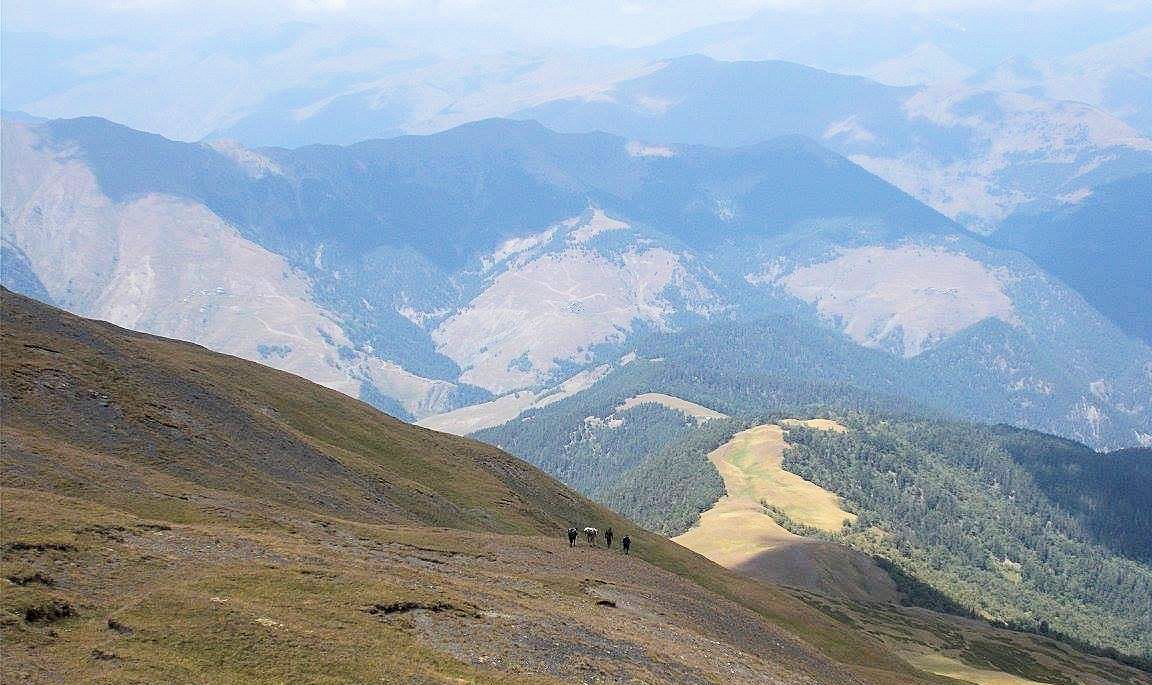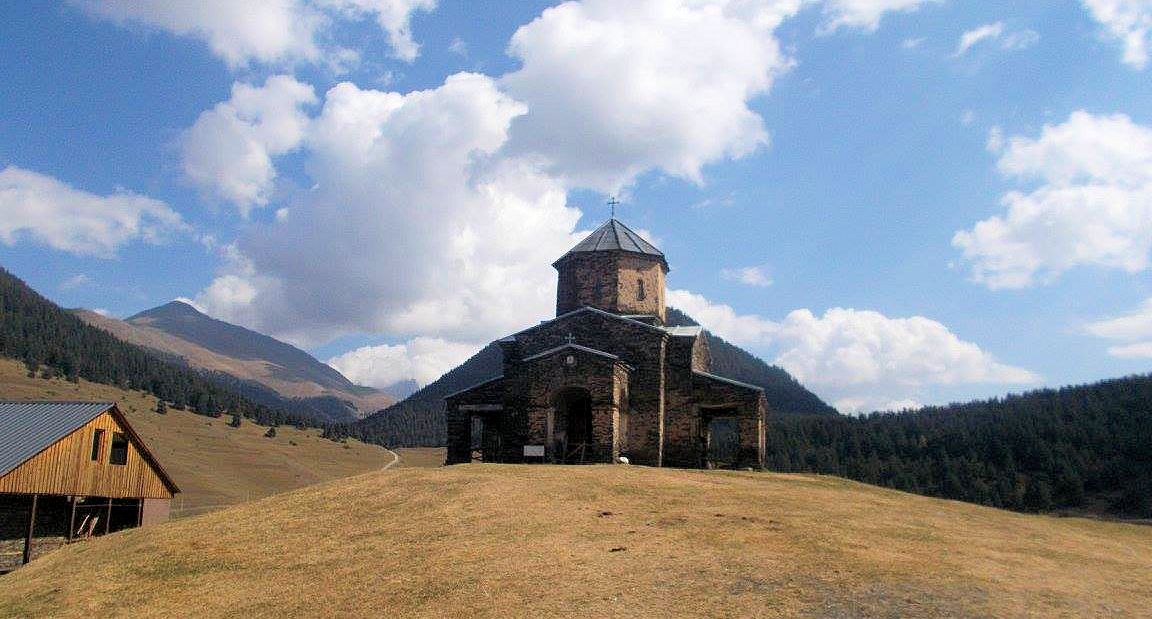
Day 4
It’s always further than it looks
It’s always taller than it looks
And it’s always harder than it looks.
We had learned the hard way on the previous day that the only way to get onto most ridges was to hire a driver, so as a result we were picked up at 8 am and were dropped at the village of Kumelaurta.
The driver took all the shortcuts, used his phone on the hair-raising switchbacks and also on occasions roared out the window “the head on you and the price of cabbages” or the local equivalent whilst listening to the local folk music.
Kumelaurta is a pretty pristine village perched on the hillside - we arrived as a local was cleaning his teeth in the local fountain. We passed the pagan statue overlooking the village and valley and headed up into the forest.

Pagan statues in Kumelaurta
We shortly met some Georgians who were also hiking and before long we arrived at a shepherd's hut in the area called Laa where the trees started to thin out. We knew we were at the last part of the climb, so we moved rapidly through the meadows and small slopes until we arrived at the Oreti lake.
It was here that we had our first encounter with the infamous Georgian mountain dogs as they were looking after a herd of sheep. As we found out, they can be very aggressive.The lake is located at 2615 metres, however, it was sadly very shriveled up as there was not much rain in the preceding few weeks. It was roughly half the depth it should have been but it was a warm summer and most of the water had evaporated.

Oreti lake in late August

Locals coming from Dagestan
Seeing as it was still early we decide to climb up to the Oreti pass - we reached it after a stiff 400-metre climb or so. There was yet again another unbelievable view, on the left stretched the Dagestan border to the peak of Shavikide (3578m).

The view from Oreti pass (3002 meters)
On either side of this pass there were two peaks. First, I went up Shagoura East (3151m) whilst Martin waited on the ridge. I flew up the few hundred metres to the top and just below it I came upon a shepherd’s rifle cap and lunch left on the rocks. I climbed further and saw the shepherd in a shallow dip below with sheep and another of those dogs, so I left quickly and headed back down to the pass. This high point was 150 metres as the crow flies to the Dagestan border or half an hours climb to the peak of Encho (3304m).
I reached the pass and I climbed up the other peak to Shuagora (3156m). This was a far steeper climb and it had an even nicer vista. I stopped for a while to soak in the view. Then started the long walk back down the hill through the forest to the river. This was followed by another walk up the hill to the village of Upper Omalo. The village has a population of around 300 to 450 in the summer which reduces to around 30 for the winter after the Abano pass closes.

Shuagora from Shuagora East mountain
That night as we sat around the campfire, looking up at the stars, the peacefulness was interrupted by the four horsemen of the Apocalypse who roared through the darkened village on horseback yahooing and setting every dog howling from one end of the village to the other. In Tusheti anything can and does happen.
Day 5
Don’tcha know that there
Ain’t no mountain high enough
Ain’t no valley low enough
Ain’t no river wide enough
Ain’t mountain high enough
Ain’t no valley low enough
Aint no Mountain High Enough
This morning I arranged a lift to the village of Shenako. As I had some time, I looked around the village of Upper Omalo, which had one small church, few guesthouses and a lot of building repair work going on. The car arrived at 10 am. and off I went. After a 40-minute hair-raising ride down to the valley floor and a back up the far side, we reached the village of Shenako.
Cars are banned from the main street (track) so I strolled through the gate and started to look around. Shenako, like most villages here, is in places either sadly dying of neglect or were in a good state of repair. I strolled along the main street until I got to a broad meadow - at the other end, there was a wonderfully picturesque church. In sharp contrast to the small baroque church in Omalo, this one was wonderfully painted inside and was full of icons.

Shenako church
I dropped down from the church onto the track and proceeded towards Diklo which was a 2 km walk between wooded mountains. Eventually, I reached Diklo, passed through another gate and continued through the village to follow a zig-zag path with streams to cross and clean enough to fill the water bottle. That path leads to Diklo castle, situated on a promontory which had a drop of 1000 feet in 3 directions.

Trail to Diklo
I stopped on the ridge just above the castle to examine a monument to a local man who died a few years ago in a conflict in Abkhazia. Then I heard a shout “Come here, come here”. A burly man in combat trousers with an AK47 beckoned me. “Border guard”, he said, so I wandered over and was brought to the tent that they lived in. There was a table there underneath the tree where a further two AK47’s were hanging off a branch.

Memorial
I sat down and produced my papers, which this man and another border guard brought into the tent. I waited and looked across the gorge to Chechnya. Soon one of the men returned and asked me where I was going. "To Diklo castle", I advised…”Slowly, slowly, snakes” he said …being used to snakes and other vermin in Leinster house that was not going to bother me too much.
I asked whether I could climb Shavikvishka (3209m) afterward. “No”, he said, “that is a holy mountain”. So I set off for the castle and after a brief scramble I reached the top and could see the hugely impressive valleys and mountains that mark the border here. I returned to Diklo via the long zig zag path and passed through the village.

The flag at the border post

Ruins of Diklo fortress

Diklo from Diklo fortress
Shortly afterward, I took a turn to the right and headed through the trees and up the steep slopes to the grassy peak of which was located at 2607m. However, it was not quite the same as I headed along the ridge towards Samekhe. The narrow ridge here had numerous blown trees and after a long and torturous scramble I arrived at the radio tower at Samekhe (2496m) and started the very steep descent down to the village of Shenako.

Dagestan from Samekhe mountain
When I arrived at the village, the local Georgian dogs took an interest in me and only a timely intervention by a local who had to leave her giant loom on a nearby verandah saved the day. The verandahs are part of each and every house here, a very welcome break in the shade from the searing heat of the day.
Now the difficult part of the day began, the long and torturous walk back to Omalo through all the switchbacks going down one side of the valley over the river and another long series of switchbacks going up the far side. Eventually, after a long and boring two-hour slog I reached the village of upper Omalo. A much-needed glass of wine was called for.
Day 6
True you ride the finest horse I’ve ever seen
Standing 16 1” or 2” with eyes wild and green
And you ride the horse so well, hands light to the touch
I could never go with you no matter how I wanted to
Ride On (by Christy Moore)
Today was a rest day so Martin decided to go for a horse ride with a German Aussie called Phil. The horses and the guide did arrive around two hours late. After the exertions of the previous four days, I was happy to write my notes up, rest and help the preparation for Rosa’s 23rd birthday. The day was interrupted by various NGO’s and Georgians coming and going. Eventually, Phil and Martin came riding back having visited the famous cheese man in Bochorna as part of their ride and sampled his cloudy homemade cider.
Before it got dark, the tables in the space in front of the hostel were filled with beer, cha-cha, wine and vodka. The food flowed from many dishes in the table and the NGO’s and Georgians came back and the party started in earnest. We all had to do a toast (In Georgia everyone is expected to) to the birthday girl.
Eventually the toast of the evening was made “May your ducks never drown, may your hens always lay eggs and may the crows never pick your stack!” this was met by bemusement……the loud roars in the background of “Up Da Village” did not help matters…maybe there was drink taken….
Tush song “Ra Lamazia Tusheti“ or in English “How beautiful Tusheti is”. The cake was then produced and traditionally the heart of the cake was cut out for the birthday girl. Who after eating the heart of the cake had to do a toast to the rest of the people still sitting there.
As the log fire nearby was dying out, I was called upon to revive it as the lad looking after it was too drunk to do so. A few more hours of drink and chacha, singing and chacha, talking and chacha, the party was over and it was time for bed.
Day 7
Up through an empty house of stars,
Being what heart you are,
Up the inhuman steeps of space
As on a staircase go in grace,
Carrying the firelight on your face
Beyond the loneliest star.
The ballad of the white horse
Our driver arrived just after 10. am and it was time to say goodbye to the wonderful valley of Tusheti. The people, the landscapes, the food, everything about this place is as perfect as the Georgians say. In fact, you can see why the Georgians regard this as their “Shangri-La”. The 69 km epic journey began again over the Abano pass and it was back to Tbilisi for a few days before flying home on the awfully timed flight at 04.00 am
In essence, Tusheti is an oasis of culture, tradition, and nature in the desert of modern life. Its culture and resilience are in sharp contrast to the vacuous consumerism, and inane idiocy of reality tv and celebrity culture that infests modern life.













